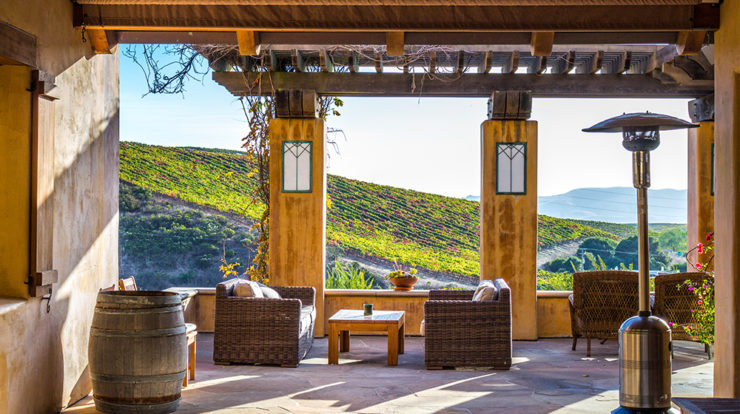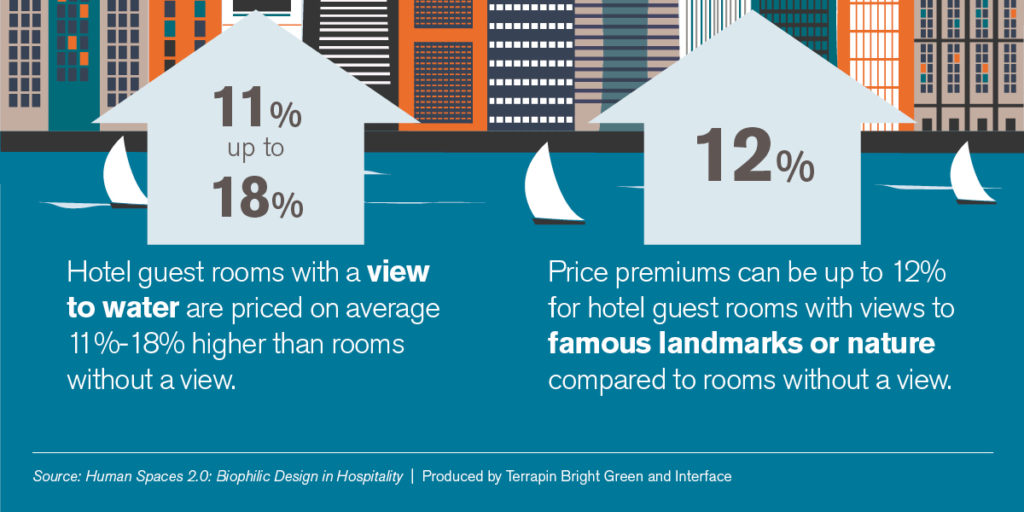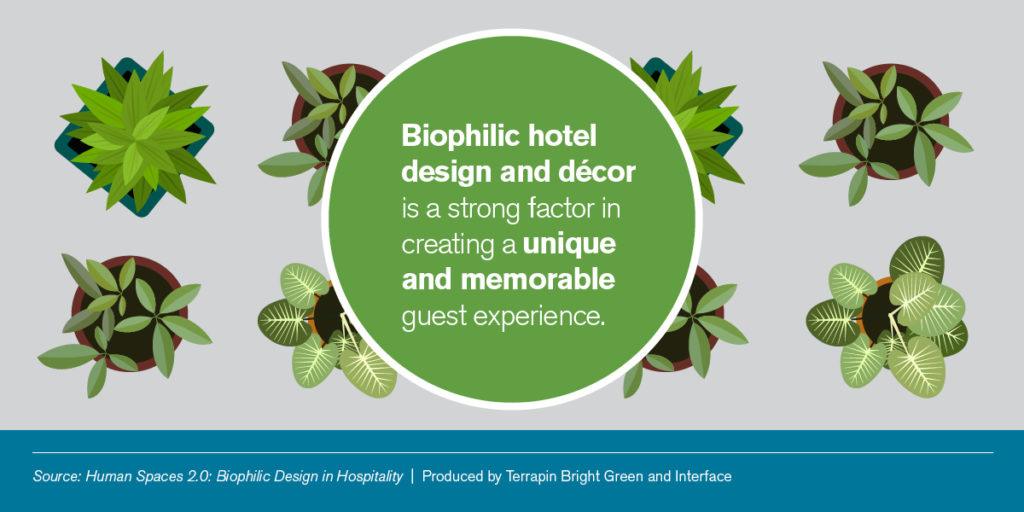

Project Profiles
Human Spaces 2.0: Biophilic Design in Hospitality
Rebecca Macies
Share
Learn more about our biophilic design work and services by emailing us at [email protected] and reading our reports, 14 Patterns of Biophilic Design and The Economics of Biophilia. Follow the conversation on twitter: @TerrapinBG | #14Patterns.
Over the past year, Terrapin collaborated with Interface and Gensler on a series of preliminary studies to bring clarity to biophilic design trends in hospitality. Until now, our biophilic design research has been focused on workplace wellbeing, and we were surprised to find that similar research did not exist for the hospitality industry. Our exploration of biophilic design trends has been exciting, and, in many ways, confirms what we’ve learned: biophilic design contributes to a memorable guest experience.
The results of our research are compiled in the new Human Spaces 2.0 report.
Hotels.com Analysis
Our first investigation was to determine if hotel operators are recognizing the value of a common biophilic feature: a view of nature. We took a common assumption, that a hotel room with a view to nature comes with a price premium, and asked, “How much more?” Our quantitative analysis from Hotels.com showed up to an 18% increase in average daily rate.

Onsite & Global Snapshot Surveys
Next, we expanded our view of the guest experience from the guest room to include hotel amenities. To understand the types of biophilic experiences hotels are offering, we created a survey to assess hotel amenities using the 14 Patterns of Biophilic Design. The survey findings are reflected in a series of case studies each discussing a different amenity: Lobbies, Guest Rooms, Food & Beverage, and Spas.
User Trends Review
We also conducted a review of lobby user trends comparing biophilic lobbies with conventional lobbies. Is there a correlation between biophilic design and guests spending more time in the lobby? Is biophilic design instrumental in making the lobby a destination, rather than just a transient space? Our observations found that it can, with 36% more hotel guests spending time in hotel lobbies that had biophilic elements.
Online and Marketing And Guest Review Comparison
Finally, we looked at what hotels and their guests themselves were saying. The results spoke volumes. We reviewed the websites of biophilic and conventional hotels alongside the guest reviews of the same hotels. While maintenance and service were mentioned most in guest reviews of conventional hotels, reviews of biophilic hotels mentioned nature and design most.

Read the full report and see all of our findings in Human Spaces 2.0. The results of these studies suggest that biophilic design can play an important role in the guest experience. We’re excited by these findings and look forward to continuing research in this area.
Filed under:
Rebecca Macies
Rebecca is the Director of Operations at Terrapin and has a background in natural resource policy and management. She is interested in how policy helps shape our relationship to nature, and how we can work with and learn from natural systems to address human needs.
Topics
- Environmental Values
- Speaking
- LEED
- Terrapin Team
- Phoebe
- Community Development
- Greenbuild
- Technology
- Biophilic Design Interactive
- Catie Ryan
- Spanish
- Hebrew
- French
- Portuguese
- Publications
- Occupant Comfort
- Materials Science
- Conference
- Psychoacoustics
- Education
- Workshop
- Mass Timber
- Transit
- Carbon Strategy
- connection with natural materials
- interior design
- inspirational hero
- biophilia
- economics of biophilia
- Sustainability
- wood
- case studies
- Systems Integration
- Biophilic Design
- Commercial
- Net Zero
- Resorts & Hospitality
- Energy Utilization
- Water Management
- Corporations and Institutions
- Institutional
- Ecosystem Science
- Green Guidelines
- Profitability
- Climate Resiliency
- Health & Wellbeing
- Indoor Environmental Quality
- Building Performance
- Bioinspired Innovation
- Biodiversity
- Residential
- Master Planning
- Architects and Designers
- Developers and Building Owners
- Governments and NGOs
- Urban Design
- Product Development
- Original Research
- Manufacturing
- Industrial Ecology
- Resource Management
- Sustainability Plans
- Health Care
- Carbon Neutrality


